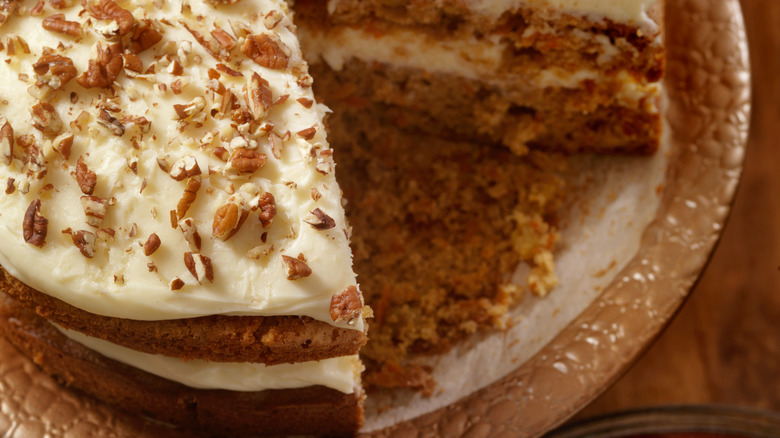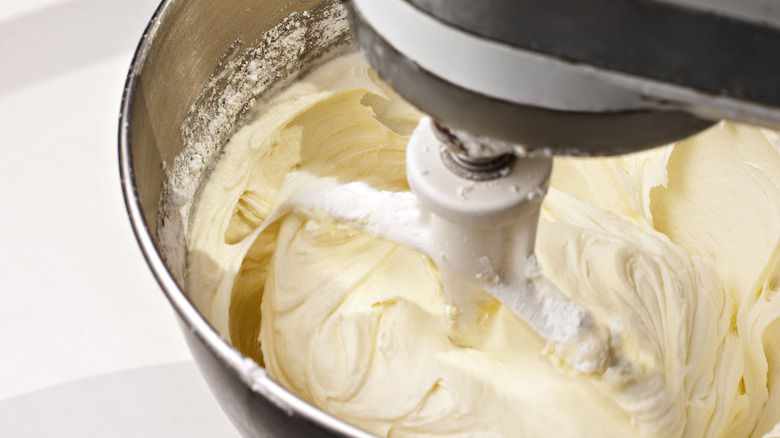Here's How Long That Fresh Carrot Cake Will Last Out Of The Fridge
When life gives you carrots, it's time to make carrot cake. You can source carrots at the grocery store year-round in the U.S., so anytime is a good time to grate up a pile of fresh carrots and bake a sweet treat. Carrot cake is simple to make and is relatively foolproof compared to other popular cake styles. Plus, you can dress it up or down with lots of different ingredients, including spices, nuts, and dried fruit. What you can't do, however, is leave carrot cake out on the counter indefinitely. If you want to keep carrot cake in tip-top shape from beginning to end, the FDA recommends that you don't leave it on the counter for any longer than two hours.
A big part of what makes carrot cake so moist and delicious is that it's made with multiple dairy products. Even when the cake is baked, bacteria can still grow, so everything still needs to be refrigerated to prevent spoilage and foodborne illness. Carrot cake and frosting are also easier to tame when they're cold, so unless it's time to serve up some slices, keep your cake in the fridge.
Don't let carrot cake be a breeding ground for bacteria
Carrot cake has been around for centuries; historians can trace its origins back to medieval times. But just because the cake was created before refrigeration was invented doesn't mean it can sit out at room temperature for hours. We know a lot more now about microscopic bacteria that grow in food than we did hundreds of years ago, including the foods that are most likely to make us sick.
Carrot cake is dense and moist thanks to some combination of butter, milk, eggs, buttermilk, sour cream, and cream cheese, all of which are perishable and are breeding grounds for bacteria, including Salmonella. Even when a cake is baked, those ingredients still need to be refrigerated — bacteria can start to grow after only a few hours at room temperature.
For example, you wouldn't leave a cooked quiche out on the counter, because you know it'll make you sick. The same is true for carrot cake; bacteria can (and will) grow in cooked eggs that are left in the temperature danger zone of 40 and 140 degrees Fahrenheit, according to the CDC. In addition to the cake itself, the cream cheese frosting and buttermilk glaze for your carrot cake need to be refrigerated.
Cold cake and frosting are easier to work with
There are other benefits to refrigerating carrot cake, too. Cream cheese frosting and carrot cake are a little unruly when they're warm, so the fridge is your friend.
The cake itself is much easier to frost and slice when it's been refrigerated — the soft, moist crumb contracts when it's chilled and doesn't tear or fall apart as easily. Similarly, cream cheese frosting is sticky and goopy when it's warm, so it's a lot easier to cut picture-perfect cake slices when it's cold. The only time you need cream cheese frosting to be room temperature is when you're spreading it on the cake layers during construction. The rest of the time, warm cream cheese frosting will only stick to the blade of your knife when you go to cut the cake, which will pull the crumb apart and make messy slices.
The bottom line is, if you're not actively eating carrot cake, you should store it in the fridge to be on the safe side. If you do have cake on the table for entertaining, follow the two-hour rule to keep it fresh and safe to eat. With these simple guidelines, you'll never have to toss any cake in the trash because you're not sure if it's spoiled. And you'll always cut crisp, perfect slices.


